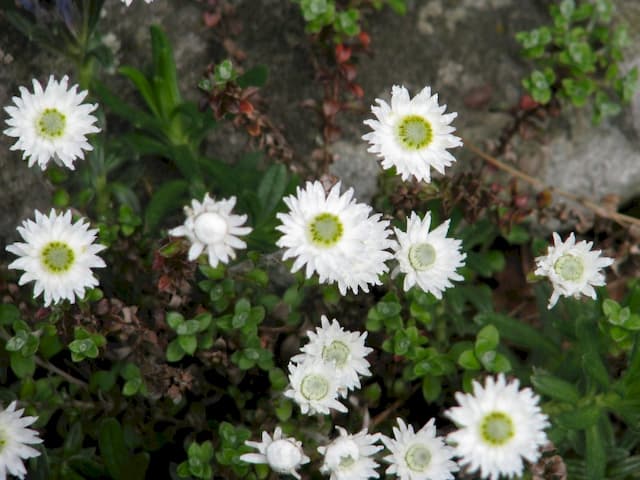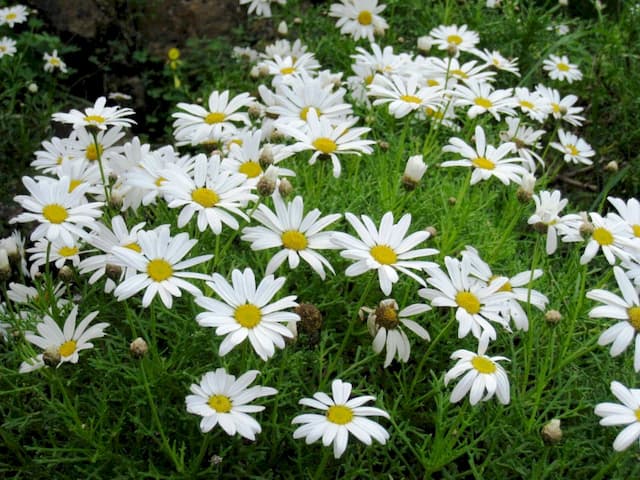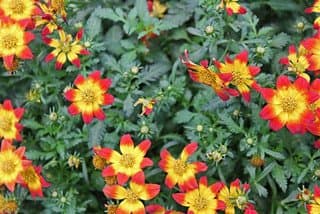Cornflower 'Black Ball' Centaurea cyanus 'Black Ball'

ABOUT
'Black Ball' is an upright annual to 75cm, with simple or slightly lobed leaves and solitary, very dark red flower-heads 3-4cm across in late spring and summer
About this plant
 Names
NamesFamily
Asteraceae
Synonyms
Bachelor's Button, Cornflower, Bluebottle, Boutonniere Flower, Hurtsickle
Common names
Centaurea cyanus 'Black Ball'.
 Characteristics
CharacteristicsLife cycle
Annuals
Foliage type
Deciduous
Color of leaves
Green
Flower color
Burgundy
Height
2' 6" (76 cm)
Spread
1' 0" (30 cm)
Plant type
Herb
Hardiness zones
3
Native area
Europe
Benefits
 General Benefits
General Benefits- Attracts Pollinators: The plant is known for attracting bees and butterflies, which are essential for pollination and maintaining a healthy ecosystem.
- Aesthetic Appeal: With its unique dark burgundy to almost black flowers, this variety of cornflower adds a striking visual contrast to gardens and landscapes.
- Easy to Grow: Cornflower 'Black Ball' is low maintenance and can thrive in a range of soil types, making it suitable for novice gardeners.
- Drought Tolerant: Once established, the plant is quite resilient and can withstand periods of low water availability.
- Edible Flowers: The petals of the cornflower can be used to add color to salads and other dishes, although they should be consumed in moderation.
- Cut Flower: The blooms make long-lasting cut flowers, which are great for floral arrangements and bouquets.
- Wildlife Friendly: The plant provides habitat and food for various insects, contributing to local biodiversity.
 Medical Properties
Medical Properties- Anti-inflammatory: Cornflower has been traditionally used for its anti-inflammatory properties to help soothe skin irritation and inflammation.
- Astringent: The astringent property of Cornflower allows it to be used in tightening the skin and toning the pores which is beneficial in various skin conditions.
- Ophthalmic: Cornflower water has been used for eye washes to soothe eye irritation and fatigue, although this use is mainly traditional and not widely supported by scientific evidence.
 Air-purifying Qualities
Air-purifying QualitiesThis plant is not specifically known for air purifying qualities.
 Other Uses
Other Uses- Fabric Dye: The deep shades of blossoms from the Cornflower can be used to produce natural dyes for coloring fabrics.
- Eco-Friendly Confetti: Dried petals of the Cornflower can serve as an environmentally friendly alternative to traditional paper confetti at celebrations.
- Art Supplies: The petals can be used to make natural inks or pigments for painting and other artistic endeavors.
- Culinary Garnish: Edible flowers of the Cornflower can add color and a mild spicy flavor to salads and desserts.
- Photography: Cornflower's distinctive color makes it an excellent subject or a background in floral photography.
- Education: Cornflower can be used in botany and horticulture education as an example of plant morphology and biology.
- Crafts: Dried flowers can be used in scrapbooking, card making, or other paper crafts for decoration and texture.
- Natural Potpourri: The dried petals can be added to potpourri mixes to impart color and a subtle fragrance to a room.
- Bookmark Embellishments: Pressed Cornflower blooms can be used to decorate or create unique, handcrafted bookmarks.
- Seed Bombs: Mixing Cornflower seeds with clay and compost to create 'seed bombs' for guerrilla gardening or easy planting.
Interesting Facts
 Feng Shui
Feng ShuiThe Cornflower is not used in Feng Shui practice.
 Plant Symbolism
Plant Symbolism- Love and Affection: The deep, rich color of 'Black Ball' (commonly known as Cornflower) is often associated with feelings of love and devotion, symbolizing a strong, passionate connection between individuals.
- Hope: Traditionally, Cornflowers represent hope and the beauty of nature, reflecting an optimistic outlook and the belief in a positive future.
- Fertility: In some cultures, the Cornflower is a symbol of fertility, likely due to its association with flourishing fields and bountiful harvests.
- Delicacy: Despite their vibrant appearance, Cornflowers are quite delicate, symbolizing a sense of gentleness and the need to handle relationships with care.
- Royalty: The regal hues of the 'Black Ball' variety can evoke a sense of nobility and richness, often associated with royalty and elegance.
- Remembrance: In some countries, Cornflowers are used as a symbol of remembrance for fallen soldiers and to honor those who have served in conflicts.
 Water
WaterBachelor's Buttons, commonly known as Black Ball, thrive when the soil is kept evenly moist, especially during their active growth in the spring and summer. They should be watered thoroughly whenever the top inch of soil feels dry to the touch, which typically might be once or twice a week, depending on climate conditions. When watering, aim to provide enough water to reach the roots, about one inch of water. During hotter periods, you might need to water more frequently, and less so during cooler or rainy spells. It's important to avoid overwatering, which can lead to root rot.
 Light
LightBachelor's Buttons require full sun to partial shade to flourish. The ideal spot for these plants offers at least 6 hours of direct sunlight per day. They are versatile and can tolerate a little shade, but the best flowering occurs in a location where they can bask in the sun’s rays for most of the day.
 Temperature
TemperatureBachelor's Buttons can tolerate a range of temperatures and are quite hardy against the cold. They can survive in temperatures as low as 10°F but ideally prefer the range of 60°F to 75°F. The plants can handle occasional fluctuations above and below this range but may suffer during prolonged periods of extreme temperatures.
 Pruning
PruningBachelor's Buttons can be pruned to encourage bushier growth and more blooms. Deadheading, or the removal of faded flowers, should be done regularly to promote continuous flowering. Pruning can be conducted post blooming to tidy up the plant and decrease self-seeding if not desired. The best time for pruning is late summer or after the flowering season has completed.
 Cleaning
CleaningAs needed
 Soil
SoilCornflowers like 'Black Ball' thrive in well-draining soil with a pH range of 6.1 to 7.8. A good soil mix for this plant would be one part garden soil, one part peat moss or coconut coir, and one part perlite or sand to ensure proper drainage while still retaining some moisture.
 Repotting
RepottingCornflowers such as 'Black Ball' usually do not require frequent repotting as they are annuals. However, if you're growing them as perennials in a container, repotting every 2-3 years or when root-bound will suffice.
 Humidity & Misting
Humidity & MistingCornflowers like 'Black Ball' are adaptable and can tolerate a range of humidity levels but prefer a drier atmosphere. They do well in outdoor conditions where humidity is not excessively high.
 Suitable locations
Suitable locationsIndoor
Place in a sunny spot and water moderately.
Outdoor
Plant in full sun, water well, and protect from strong winds.
Hardiness zone
2-11 USDA.
 Life cycle
Life cycleThe life of the 'Black Ball' Cornflower (Centaurea cyanus 'Black Ball') begins with seed germination, typically in the spring, as temperatures rise and conditions become suitable for growth. The seedling stage involves the emergence of the cotyledons and the first true leaves, with the plant focusing on root and foliage development. As it enters the vegetative stage, the plant grows rapidly, developing a stronger stem and more extensive leaf structure in preparation for reproduction. Flowering occurs in early to mid-summer, with the 'Black Ball' variety producing distinctive dark maroon to almost black blossoms that attract pollinators. Following pollination, the flowers develop into seed heads, containing seeds that will disperse to initiate the next generation. The plant completes its life cycle by entering senescence after seed dispersal, where it begins to die back, typically succumbing to frost in colder climates, having ensured its propagation through the seeds it has produced.
 Propogation
PropogationPropogation time
Spring-Early Summer
The Cornflower 'Black Ball', scientifically known as Centaurea cyanus 'Black Ball', is commonly propagated by seeds. The ideal time to sow Cornflower seeds is in the spring after the risk of frost has passed, or in the autumn where climates permit. To propagate by seeds, you merely need to scatter the seeds on top of a well-draining soil mix and lightly press them into the surface, as they need light to germinate. Keep the soil moist but not waterlogged. Germination usually occurs within 1 to 2 weeks under optimal conditions, which include plenty of sunlight and temperatures ranging between 60 to 70 degrees Fahrenheit (15.6 to 21.1 degrees Celsius). Once seedlings are large enough to handle, they can be thinned out or transplanted to their final growing positions, ensuring they are spaced approximately 12 inches (30 centimeters) apart to allow for proper growth and air circulation.









